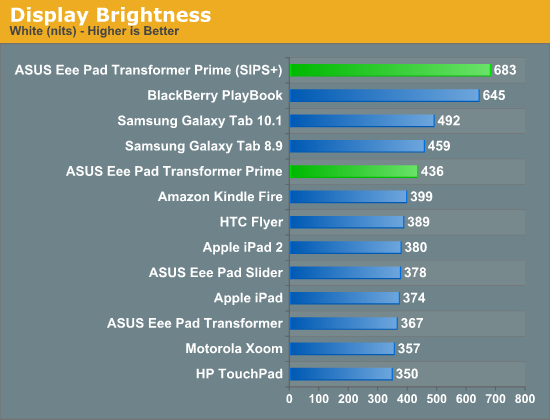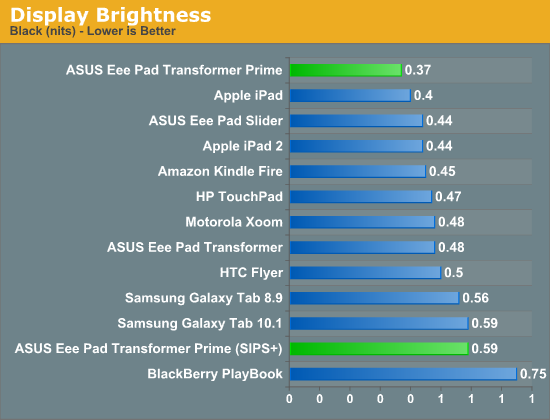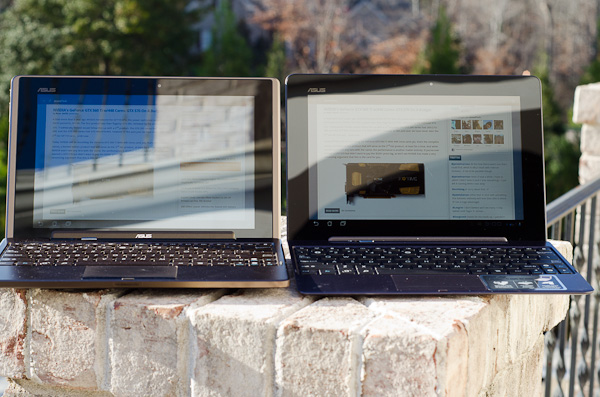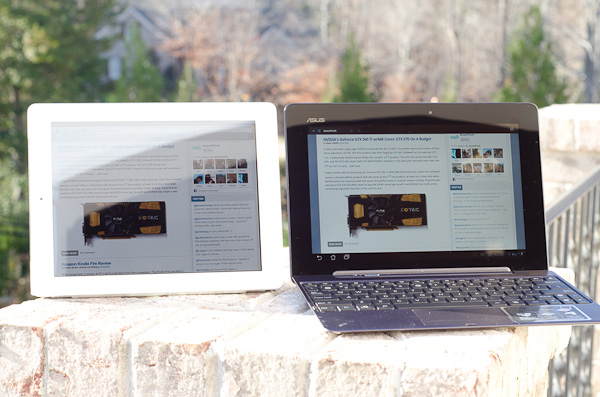ASUS Eee Pad Transformer Prime & NVIDIA Tegra 3 Review
by Anand Lal Shimpi on December 1, 2011 1:00 AM ESTThe Display: Perfect
The original Transformer had a display that performed similarly to the iPad, but was far more reflective thanks to a fairly large gap between the outer glass and the LCD panel underneath. I excused the first generation Eee Pad in the display department because it was good enough and $100 cheaper than the competing Apple solution. The Prime reaches price parity with the iPad 2, and as a result it must meet a higher standard. ASUS doesn't disappoint - the Eee Pad Transformer Prime has the best display I've seen on a tablet to date.
The resolution is a Honeycomb-standard 1280 x 800. The 16:10 panel measures 10.1-inches diagonally, giving it a very similar surface area to the iPad 2's 9.7-inch 4:3 display. The increase in resolution more than makes up for the larger screen however, ASUS delivers 145 pixels per inch compared to the iPad 2's now quite-dated ~132 PPI.
It's not all about pixel density here, the Transformer Prime has better white and black levels than anything else in its class. It also sets the new benchmark for contrast ratio at nearly 1200:1. The huge gap between the outermost glass and the IPS LCD panel has been reduced significantly, in turn reducing glare.



ASUS also has a Super IPS+ mode that drives the display to a class-leading 683 nits. The Super IPS+ mode obviously draws more power but ASUS recommends it if you're trying to use your tablet outdoors. In our review of the PlayBook we found that 600 nits was really the cutoff for usability in sunny conditions, and ASUS easily exceeds that. It's also worth pointing out that while Super IPS+ increases black levels as well, the resulting contrast ratio remains the same.

Original TF (left) vs. Super IPS+ enabled on the TF Prime (right)

iPad 2 (left) vs. Super IPS+ enabled on the TF Prime (right)
Viewing angles are absolutely awesome. Yes this is the same ASUS that let us down with the UX panels but it definitely got the panel right when it came to the Transformer Prime. Fingerprints are still going to be evident on the display but they don't seem to be as bad as on the original Transformer, and they do wipe off easily. This time around ASUS bundles a microfiber cloth to aid in keeping your Transformer looking fresh.
ASUS, Apple and the rest of the tablet world are in hot pursuit of even higher resolution panels, the problem is yields on these small 1080p and 2048x1536 panels just aren't high enough yet. The Android crowd will have to wait, although Apple is apparently pushing very hard (and trying to buy up a lot of inventory) to deliver a "retina display" equipped iPad 2+/3 by Q2 next year. I'm hearing Q3/Q4 for everyone else and it's still not a guarantee that Apple will be able to meet its aggressive targets either at this point.










204 Comments
View All Comments
MiSoFine - Thursday, December 1, 2011 - link
my 2 cents...get a Kindle fire. Easier UI for non tech parents & it's still android; cheaper also. Or a Vizio vTab.I got my Mom a Kindle Fire, kids a vTab (they will at least attempt to try to figure it out) & myself a (preordered) Prime.
steven75 - Saturday, December 3, 2011 - link
Considering the complete lack of Android tablet apps, that doesn't seem wise.Enkur - Thursday, December 1, 2011 - link
What is that android app that shows the per core CPU activity in the screenshot above?Lucian Armasu - Thursday, December 1, 2011 - link
Anand, just remember to note, or even test the real world performance when iPad 3 and other high resolution tablets arrive.In your benchmarks they should be showing even faster performance at 720p with the upcoming faster chips, but that might not be the case in the real world. Remember how low FPS the iPhone 4 got with its 4x the resolution over iPhone 3GS, when tested at native resolution?
That should be happening to iPad 3 and the others, too, even if the chips get faster by then. I would wait until at least 2013 to get a 2k resolution tablet, so I won't be that significantly impacted by it.
Lucian Armasu - Thursday, December 1, 2011 - link
Also is there a way to compare the graphics between Tegra 3 and iPad 2 without comparing the benchmark numbers? Like comparing the best graphics on Tegra 3 versus the best one on iPad 2, and notice the differences between them? I really don't think the benchmark numbers tell the whole truth.I think Tegra 3 games may even look/work better than A5 games, thanks to its quad core CPU, too, but I figure you should be able to tell that better than me since you have both.
vision33r - Thursday, December 1, 2011 - link
I disagree, in PC and Console world, the GPU is the determining factor in game graphics and performance.You can take a Core i7 using HD3000 integrated graphics and compare it with a Core i3 with an ATI 4850 and it will spank the Core i7 in gaming performance.
That's what's happening here is the Tegra 3's GPU is underwhelming from a graphics chip maker.
Very few mobile games imo need even dual core, they need the proper graphics acceleration and that's where Android fragmentation has hurt game development.
They have to code games for the lowest common denominator instead of optimizing games for Tegra.
metafor - Thursday, December 1, 2011 - link
That doesn't necessarily translate to the mobile world. On the desktop side, CPU's have gotten so fast that just about any task a game can throw at it -- physics, AI, audio, etc. -- can be done without bottlenecking the game while the shading/rendering on the GPU is still being pushed.On the mobile side, this may not be true (yet) as the CPU's are -- comparatively -- fairly underpowered against their desktop counterparts. Couple this with the fact that the GPU is taxed to push out less pixels and one could easily see situations where the CPU becomes the bottleneck.
As mobile CPU's get faster -- especially with the A15/Krait generation -- this will become less and less of an issue especially as games make use of NEON to do their computationally heavy tasks and we'll get to a point where the GPU is the only bottleneck left.
But I don't see that happening until we hit the ~2.5GHz dual A15/Krait level.
vision33r - Thursday, December 1, 2011 - link
Very few Android games that I've seen are properly optimized unless they got that Optimized for Tegra logo. Otherwise most games do not take advantage of GPU acceleration.On iOS almost all games has some sort of GPU assist. Take Plants vs Zombies, the iOS version is perfect. The Android HD version has lower animation and graphics.
Almost all Gameloft games perform smoother on iOS than on Android.
metafor - Thursday, December 1, 2011 - link
Well yes. But the point is that with a higher performance CPU or group of CPU's, it is possible to have things that would be bottlenecked in a mobile device -- such as physics, AI, etc. -- be more complex and provide better visuals.Whether or not that has been done is another story. But you can hardly blame application devs for pouring more focus into iOS. The iPad is still what, ~90% of the tablet market? Moreover the App Store brings in way more revenue -- which the developers get a cut of -- than Android Market has thus far.
That will hopefully change over time.
steven75 - Saturday, December 3, 2011 - link
The problem with that theory is iPhones still bring in vastly more revenue for developers than android phones, despite the latter having higher market share.